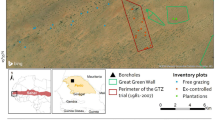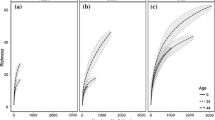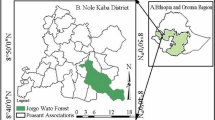Abstract
We studied the dominant species by age category of re-growth, and how subsistence forest use through shifting cultivation impacted on the floristic composition of Baikiaea forest. For re-growth stands, variable sampling method was adopted in data collection while in mature stands, a sample plot size of 50 m × 50 m was used at each of three study sites. Distribution of species by age categories showed that shrub, herb, and grass species were abundant in young re-growth stands while woody vegetation became common with increasing age of the re-growth stand. Hierarchical clustering for common woody species showed several species associations with age categories and also with relatively undisturbed woodland. Common regeneration mechanisms of key woody species were mainly by seed (48%), coppicing (40%) and root suckers (12%). The young re-growth stands of 6–10 and 11–15 years were characterized by B. petersiana, B. massiensis, Combretum zeyheri, and Guibourtia coleosperma. Older stands (16–20 years after abandonment) were characterized by B. plurijuga, Pterocarpus antunesii, and Baphia massiensis, thus closely mimicking the relatively undisturbed forest whose dominant key woody species were B. plurijuga, P. antunesii, and G. coloesperma. There were many stems in younger stands (2–5 years) and fewer stems in older re-growth stands of 16–20 years after abandonment following shifting cultivation. Older re-growth stands (16–20 years) were similar to undisturbed stands (P < 0.005). The similarity between re-growth stands of 16–20 years and control stands demonstrates the recovery of Baikiaea forest over time after cessation of shifting agriculture. Baikiaea forest requires some disturbance to perpetuate the dominant species and begins to show signs of recovery from shifting cultivation within 16–20 years after abandonment. This is contrary to assertions that this ecosystem could take up to about 100 years for abandoned fields to begin showing signs of recovery






Similar content being viewed by others
References
Bellingham PJ, Sparrow AD (2000) Resprouting as a life history strategy in woody plant communities. Oikos 89:409–416
Calvert GM (1986) The exploitation of Zambezi teak in Zambia. In: Piearce GD (ed) The Zambezi teak forests. Proceedings of the first international conference on the teak forests of southern Africa, March 1984, Livingstone, Zambia, pp 329–341
Central Statisitical Office (CSO) (2010) Living conditions monitoring survey report 2006 and 2010. Living conditions Monitoring branch, Central Statistical Office, Lusaka
Chidumayo EN (2004) Development of Brachystegia–Julbernadia woodland after clear felling in Central Zambia: evidence for high resilience. Appl Veg Sci 7:237–242
Childes SL, Walker BH (1987) Ecology and dynamics of the woody vegetation on the Kalahari sands in Hwange National Park, Zimbabwe. J Veg Sci 72:111–128
Dayamba SD, Savadogo P, Sawadogo L, Zida D, Tiveau D, Oden PC (2011) Dominant species’ resprout biomass dynamics after cutting in the Sudanian savanna-woodlands of West Africa: long term effects of annual early fire and grazing. Ann For Sci 68(3):555–564
DFSC (2001) Conservation plan for genetic resources of Zambezi teak (Baikiaea plurijuga) in Zambia. Case studies No. 2: Danida Forest Seed Centre, Humlebaek, Denmark, p 18
DWAF (2005) Sustainable resource use. PFM guideline for Department of Water Affairs and Forestry. DWAF, Ramboll & Danida, Pretoria, p 104
Fanshawe DB (1971) The vegetation of Zambia. Government Printers, Lusaka, p 22
Geldenhuys CJ (1993) The use of diameter distributions in sustained-use management of forests: examples from Southern Africa. In Pearce GD, Gumbo DJ (eds) The ecology and management of indigenous forests in Southern Africa. Proceedings of International symposium, Victoria Falls, Zimbabwe Forestry Commission and SAREC, Harare, pp 154–167
Geldenhuys CJ (2005) Basic guidelines for silvicultural and managemen practices in Mozambique. Report FW-04/05, FORESTWOOD cc, Pretoria
Geldenhuys CJ (2010) Managing forest complexity through application of disturbance recovery knowledge in development of silvicultural systems and ecological rehabilitation of natural systems in Africa. For Biol Ecol 15:3–13
Hoffmann WA, Geiger EL, Gotsch SG, Rossatto DS, On Lee Lau LCR, Haridasan M, Augusto CF (2012) Ecological thresholds at the savanna-forest boundary: how plant traits, resources and fire govern the distribution of tropical biomes. Ecol Lett 15:759–768
Huckabay JD (1986) The exploitation of Zambezi teak in Zambia. In: Piearce GD (ed) The Zambezi teak forests. Proceedings of the first international conference on the teak forests of southern Africa, March 1984, Livingstone, Zambia, pp 342–360
Kennard DK, GouldK Putz FE, Fredericksen TS, Morales F (2002) Effects of disturbance intensity on regeneration mechanisms in tropical dry forest. For Ecol Manag 162:197–208
Kikula IS (1986) The influence of fire on the composition of Miombo woodlands of Southwest Tanzania. Oikos 46:317–324
Ky-Dembele WC, Tigabu M, Bayala J, Ouedraogo SJ, Oden PC (2007) The relative importance of different regeneration mechanisms in a selectively cut savanna-woodland in Burkina Faso, West Africa. For Ecol Manag 243:28–38
Lévesque M, McLaren KP, McDonald MA (2011) Coppice shoot dynamics in a tropical dry forest after human disturbance. J Trop Ecol 27:259–268
Luoga EJ, Witkowski ETF, Balkwill K (2004) Regeneration by coppicing (resprouting) of Miombo (African savanna) trees in relation to land use. For Ecol Manag 189:23–35
Malaya FM (1986) A review of silvicultural research in the Zambezi teak forests. In: Piearce GD (ed) The Zambezi teak forests. Proceedings of the first international conference on the teak forests of southern Africa, March 1984, Livingstone, Zambia, pp 167–177
Mistry J (2000) World savannas: ecology and human use. Pearson Education Limited, Edinburgh
Mudekwe J (2007) The impact of subsistence use of forest products and the dynamics of harvested woody populations in a protected forest reserve in Zimbabwe. Ph.D. Thesis, University of Stellenbosch, RSA
Murao R (2005) A study on the shifting cultivation system in Kalahari woodland, western Zambia, with special reference to cassava management. Afr Study Monogr 29:95–105
Peter MC (2005) Sustainable harvest of non-timber plant resources in tropical moist forest: an ecological primer. www.worldwildlife.org. Accessed 12 Nov 16
Piearce GD (1986) How to save the Zambezi teak forest. Unasylva 152:29–36
Shackleton CM, Grin NJ, Banks DI, Mavrandonis JM, Shackleton SE (1994) Community structure and species composition along a disturbance gradient in a communally managed South African savanna. Vegetatio 115, 157–167.
Strang RM (1974) Some man-made changes in successional trends on the Rhodesian highveld. J Appl Ecol 11(1):249–263
Syampungani S (2008) Vegetation change analysis and ecological recovery of the Copperbelt Miombo woodlands of Zambia. Ph.D. Thesis, University of Stellenbosch, Stellenbosch, RSA
Syampungani S (2009) Vegetation change analysis and ecological recovery of the Copperbelt miombo woodlands of Zambia. PhD Thesis, University of Stellenbosch, RSA
Syampungani S, Chirwa PW, Akinnifesi FK, Sileshi G, Ajayi OC (2009) The Miombo woodlands at cross roads: Potential threats, sustainable livelihoods, policy gaps and challenges. Natural Resour Forum 33:150–159
Syampungani S, Geldenhuys CJ, Chirwa PC (2010) The use of species-stem curves in sampling the development of the Zambian miombo woodland species in charcoal production and slash-and-burn re-growth stands. South For 72(2):83–89
Syampungani S, Geldenhuys CJ, Chirwa PC (2013) Developing silvicultural systems based on disturbance-recovery knowledge of the southern African Miombo woodlands. In: Manzares L (ed) Woodland structure, species diversity and sustainable management. Nova Publishers, New York, pp 139–152
Syampungani S, Geldenhuys CJ, Chirwa PC (2015) Regeneration dynamics of Miombo woodland in response to different anthropogenic disturbances: forest characterisation for sustainable management. Agrofor Syst 90(4):1–14
Syampungani S, Tigabu T, Matakala N, Handavu F, Oden PC (2016) Coppicing ability of dry miombo woodland species harvested for traditional charcoal production in Zambia: A win-win strategy for sustaining rural livelihoods and recovery of woodland ecosystem. J. For. Res. https://doi.org/10.1007/s11676-016-0307-1
Timberlake J, Chidumayo EN, Sawadogo L (2010) Distribution and characteristics of African dry forests and woodlands. In: Chidumayo EN (ed) The dry forests and woodlands of Africa. Earthscan Publications, Bogor, pp 11–36
Trapnell CG (1959) Ecological results of woodland burning experiments in northern Rhodesia. J Ecol 47(1):129
Van Bloem SJ, Murphy PG, Lugo AE (2003) Subtropical dry forest trees with no apparent damage sprout following a hurricane. Trop Ecol 44:137–145
White F (1983) The vegetation of Africa. A descriptive memoir to accompany the UNESCO/AETFAT/UNSO vegetation map of Africa. UNESCO, Paris, p 356
Author information
Authors and Affiliations
Corresponding author
Additional information
The authors would like to thank the National Science and Technology Council for funding the project. Additionally, the authors would like to thank the Forest Department office in Sesheke District for helping in site identification.
The online version is available at http://www.springerlink.com
Corresponding editor: Yu Lei.
Electronic supplementary material
Below is the link to the electronic supplementary material.
Rights and permissions
About this article
Cite this article
Zulu, F., Syampungani, S. & Fushike, P. Recovery of Baikiaea forest of southwestern Zambia from shifting cultivation and its implications for sustainable management. J. For. Res. 30, 497–506 (2019). https://doi.org/10.1007/s11676-018-0656-z
Received:
Accepted:
Published:
Issue Date:
DOI: https://doi.org/10.1007/s11676-018-0656-z




